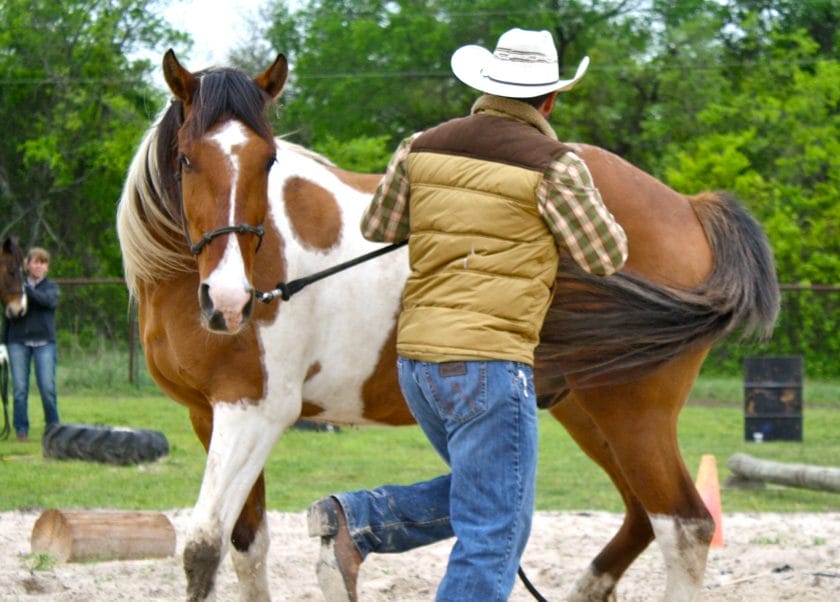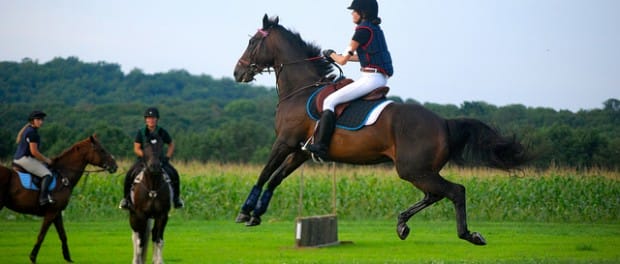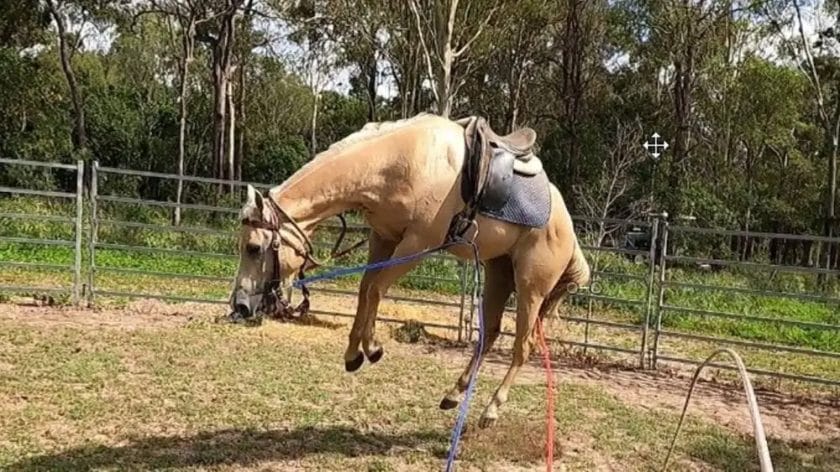A cold-backed horse refers to a horse that reacts or displays discomfort when pressure is applied to its back, especially during saddling. This behavior can range from mild stiffness to bucking and resistance. This condition is often caused by muscle tension or sensitivity in the horse’s back and can be attributed to various factors, such as poor saddle fit, previous injury, or behavioral issues. Identifying and addressing the underlying causes are essential to ensure the horse’s comfort and prevent further complications.

Training Techniques for Cold Backed Horses
Cold backed horses can pose a challenge during training due to their tendency to exhibit resistance or discomfort when first saddled or mounted. This behavior can be stressful for both the horse and the rider, but with the right training techniques, it is possible to help the horse overcome their cold back tendencies and develop a more relaxed and cooperative mindset. In this section, we will explore effective training techniques specifically designed for cold backed horses.
1. Slow and Gentle Approach
When working with a cold backed horse, it is important to take a slow and gentle approach to avoid triggering their resistance or discomfort. Start by introducing the saddle gradually, allowing the horse to sniff and inspect it before placing it on their back. Use a soft and well-padded saddle pad to ensure maximum comfort.
Next, slowly tighten the girth or cinch, one hole at a time, while continuously observing the horse’s reaction. If the horse shows signs of discomfort or tension, such as pinning their ears back or swishing their tail, release the girth or cinch and give the horse a moment to relax. Repeat this process until the horse becomes more accepting of the saddle and girth.
2. Desensitization Exercises
Desensitization exercises can be highly effective in helping a cold backed horse become more comfortable with the sensations and stimuli associated with saddling and mounting. Start by using a soft brush or towel to gently stroke the horse’s back, gradually introducing more pressure over time.
Once the horse is comfortable with being touched on their back, introduce saddle pads, blankets, or other objects that mimic the weight and feel of a saddle. Allow the horse to sniff and inspect these objects before gradually placing them on their back, simulating the process of saddling.
Continue the desensitization process by introducing the saddle in the same manner, allowing the horse to become familiar with its presence and weight. Use positive reinforcement, such as treats or praise, to reward the horse for calm behavior during these exercises.
3. Groundwork and Lunging
Groundwork exercises and lunging can be valuable tools in establishing trust and respect between the rider and the cold backed horse. Start by working on basic commands such as leading, stopping, and turning while on the ground. This will help the horse develop a better understanding of your cues and improve their overall responsiveness.
Once the horse is comfortable with groundwork exercises, introduce lunging as a way to further establish communication and encourage relaxation. Lunging can help the horse release excess energy and tension, making them more receptive to the training process.
4. Progressive Saddle Training
Progressive saddle training involves gradually increasing the duration and intensity of saddle work to build the horse’s tolerance and trust. Begin by saddling the horse for short periods, ensuring that each session ends on a positive note. As the horse becomes more comfortable, gradually increase the duration of each session.
During saddle training, focus on maintaining a relaxed and balanced position in the saddle, as this will help the horse feel more secure and less resistant. Use gentle and consistent cues to communicate with the horse, rewarding them for correct responses and remaining patient during moments of resistance.
5. Professional Assistance
If you are encountering significant challenges with training a cold backed horse, it may be beneficial to seek the assistance of a professional trainer with experience in working with such horses. They can provide valuable guidance and tailor a training program to suit the specific needs of your horse.
In summary, training a cold backed horse requires patience, consistency, and a gentle approach. By gradually introducing and desensitizing the horse to the saddle, incorporating groundwork and lunging exercises, and implementing progressive saddle training, it is possible to help the horse overcome their cold back tendencies and develop a more cooperative and relaxed attitude.

Common Misconceptions about Cold Backed Horses
When it comes to horses, there are many misconceptions and stereotypes that can be harmful and misleading. One such misconception is about “cold-backed” horses. In this section, we will debunk some of the common myths and misunderstandings surrounding cold-backed horses.
1. Cold-backed horses are inherently bad-tempered
One of the most common misconceptions is that cold-backed horses have a bad temperament. This is simply not true. Being cold-backed refers to a horse’s sensitivity or discomfort in the back or with the saddle initially. It has nothing to do with their personality or behavior. Like any other horse, cold-backed horses can have varying temperaments, but it is important not to stereotype them based on this physical characteristic.
2. Cold-backed horses are unrideable
Another misconception is that cold-backed horses are unrideable or difficult to handle. While it is true that some cold-backed horses may exhibit resistance or discomfort when first saddled or mounted, with proper training and conditioning, these issues can be resolved. Working with a knowledgeable trainer or experienced equestrian can help address any issues and ensure the horse becomes more comfortable and responsive under saddle.
3. Cold-backed horses are always in pain
There is a common belief that cold-backed horses are in constant pain or discomfort. While it is true that some cold-backed horses may have underlying back problems, it is not a universal truth. In many cases, the sensitivity or discomfort arises from muscle tension or other factors that can be alleviated with appropriate warm-up exercises and stretching. Regular chiropractic care or massage therapy can also help in maintaining the horse’s back health.
4. Cold-backed horses cannot be trained
It is often believed that cold-backed horses cannot be trained effectively. This misconception stems from the assumption that these horses are inherently difficult or uncooperative. However, with the right approach and consistent training methods, cold-backed horses can be trained just like any other horse. Patience, understanding, and positive reinforcement are key to building trust and developing a strong partnership with a cold-backed horse.
5. Cold-backed horses have limited performance potential
Some people believe that cold-backed horses have limitations when it comes to performance, such as in competitive disciplines like dressage or jumping. This is not true. While it may require additional time and effort to address the horse’s initial discomfort and sensitivity, many cold-backed horses go on to have successful careers in various equestrian disciplines. With proper training, conditioning, and management, these horses can excel and reach their full potential.
In summary, it is important to dispel the misconceptions surrounding cold-backed horses. They are not inherently bad-tempered or unrideable. With proper training, care, and understanding, these horses can thrive and achieve success in various equestrian pursuits. It is crucial to approach them with patience, empathy, and a willingness to address any discomfort they may experience.

Preventing and Managing Cold Backed Behavior
One common behavioral issue that riders often come across is cold backed behavior in horses. This refers to when a horse exhibits resistance or discomfort when being mounted or ridden after a period of rest. It can be a frustrating and potentially dangerous situation if not properly addressed. In this section, we will discuss some preventive measures and strategies for managing cold backed behavior.
Understanding Cold Backed Behavior
Before we delve into prevention and management techniques, it’s important to understand why horses exhibit cold backed behavior. There are several factors that can contribute to this behavior, including:
- Pain or discomfort in the back or saddle area
- Tension or anxiety related to the rider or the riding process
- Past negative experiences during mounting or riding
- Lack of proper training or desensitization to being mounted
By understanding the underlying causes, riders can better address the issue and take appropriate steps to prevent and manage cold backed behavior.
Preventive Measures
Prevention is always better than dealing with the problem after it arises. Here are some preventive measures that can help minimize the occurrence of cold backed behavior:
- Regular exercise: Keeping horses consistently active and engaged through regular exercise can help reduce tension and anxiety.
- Proper warm-up: Before mounting, make sure to warm up the horse properly through lunging or groundwork exercises. This helps loosen up the muscles and prepares the horse for riding.
- Check saddle fit: Ill-fitting saddles can cause discomfort and pain, leading to cold backed behavior. Ensure that the saddle fits correctly and does not put pressure on the horse’s back.
- Positive associations: Create a positive association between mounting and riding by offering treats or praise during the process. This can help alleviate any negative experiences from the past.
Managing Cold Backed Behavior
If your horse already exhibits cold backed behavior, here are some strategies to help manage and alleviate the issue:
- Professional evaluation: If you suspect pain or discomfort as the underlying cause, it is essential to consult with a professional such as a veterinarian or an equine chiropractor. They can assess the horse’s back and provide appropriate treatment if necessary.
- Gradual desensitization: Work on gradually desensitizing the horse to the mounting process. Start with light pressure on the back and gradually increase the intensity over time, rewarding the horse for calm behavior.
- Consistency and patience: Consistency is key when managing cold backed behavior. Stick to a routine and be patient with your horse’s progress. Rushing the process can lead to additional stress and resistance.
- Professional training: If you’re struggling to manage the behavior on your own, enlisting the help of a professional trainer experienced in dealing with cold backed behavior can be beneficial.
Remember, addressing and managing cold backed behavior requires time, patience, and a systematic approach. With the right preventive measures and management strategies, you can help your horse overcome this behavior and enjoy a more comfortable and stress-free riding experience.
Seeking Professional Help for Cold Backed Horses
Cold backing refers to a common problem experienced by some horses when they are saddled or mounted. It occurs when a horse reacts with discomfort or resistance, often expressing it through bucking, rearing, or other forms of resistance. This behavior can be dangerous for both the rider and the horse, making it crucial to address the issue promptly and appropriately. While there are several techniques and approaches you can try on your own, seeking professional help is highly recommended to ensure the safety and well-being of both you and your horse.
Why seek professional help?
Professional trainers and equine behaviorists have the knowledge, experience, and expertise required to diagnose and address the underlying causes of cold backing. They can assess your horse’s behavior and physical condition to determine if there are any underlying issues, such as pain or discomfort, that may be contributing to the problem. Additionally, they have the skills to develop and implement a tailored training plan to help your horse overcome their resistance and become more comfortable with saddling and mounting.
The benefits of seeking professional help:
1. Expertise and experience: Professional trainers and behaviorists have extensive experience working with cold backed horses and understand the nuances of this behavior. They can apply their knowledge to develop an effective training plan that addresses the specific needs of your horse.
2. Tailored approach: Each horse is different, and what works for one may not work for another. Professionals can assess your horse’s individual needs and develop a training program tailored to their specific behaviors and triggers.
3. Safety: Working with cold backed horses can be dangerous, especially if the behavior escalates to bucking or rearing. Professional trainers have the skills and experience to handle these situations safely, minimizing the risk of injury to both horse and rider.
4. Addressing underlying issues: Cold backing can sometimes be a symptom of an underlying physical problem, such as back pain or saddle fit issues. Professionals can identify and address these underlying issues, ensuring the horse’s comfort and well-being.
5. Continued support: Seeking professional help means having access to ongoing support and guidance. Trainers can provide follow-up sessions, advice, and assistance as you continue working with your horse.
How to find a professional:
When seeking professional help for your cold backed horse, it’s important to find a reputable and experienced trainer or equine behaviorist. Here are a few steps to help you find the right professional:
- Research: Look for trainers or behaviorists who specialize in working with behavioral issues and cold backed horses. Read reviews, ask for recommendations from fellow horse owners, and check for certifications or qualifications.
- Interview potential professionals: Schedule a meeting or phone call with potential professionals to discuss your horse’s issue and their approach to training. Ask questions about their experience, training methods, and success stories with similar cases.
- Observe a training session: If possible, observe a training session conducted by the professional you are considering. This will give you a sense of their training methods and how they interact with horses.
- Check references: Ask for references from other horse owners who have worked with the professional. Contact these references to get their feedback and insights.
- Trust your gut: Ultimately, trust your instincts when choosing a professional. Select someone who makes you feel comfortable, confident, and who aligns with your training philosophy.
In summary
Addressing cold backing in horses requires patience, expertise, and a tailored training plan. While there are techniques you can try on your own, seeking professional help is highly recommended to ensure the safety and well-being of both you and your horse. Professional trainers and equine behaviorists have the knowledge and experience to diagnose and address the underlying causes of cold backing, develop customized training plans, and provide ongoing support. Take the time to find a reputable professional who specializes in working with behavioral issues and cold backed horses, and trust their expertise to help you and your horse overcome this challenge.
FAQs
What is a cold-backed horse?
A cold-backed horse is a term used to describe a horse that reacts negatively when a saddle is first placed on its back. These horses may exhibit behaviors such as bucking, rearing, or tension in their back muscles. This reaction can be caused by discomfort, pain, or a sensitive back. It is important to address the underlying issue and work with a knowledgeable professional to resolve the problem.
Conclusion
In conclusion, understanding what a cold-backed horse is and how to manage it is crucial for both horse owners and riders. By identifying the signs of cold-backed behavior, such as resistance during mounting or bucking, and addressing it early on, you can prevent potential accidents or injuries.
Implementing a proper warm-up routine, using a well-fitted saddle and pad, and seeking professional help if needed are all important steps in managing a cold-backed horse. Additionally, establishing trust and patience with your equine companion can go a long way in building a positive relationship and overcoming any cold-back issues.
Remember, every horse is unique, and it may take time and consistency to resolve cold-backed behavior. With the right approach, patience, and understanding, you can help your horse feel more comfortable and confident, ensuring a safer and more enjoyable riding experience for both of you.
